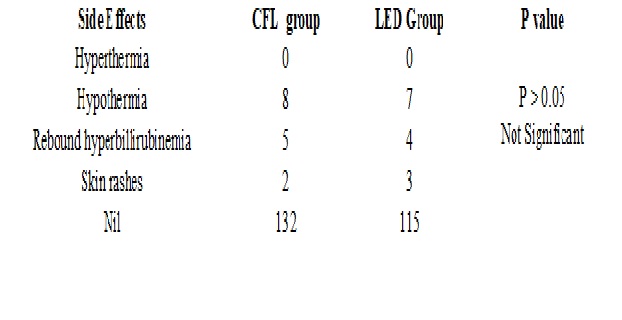Comparative study between CFL and LED phototherapy devices for unconjugated hyperbilirubinemia in neonates
Abstract
Background: Neonatal hyperbillirubinemia is a common condition encountered in newborn. Phototherapy is a non invasive, cheap and safe modality for treatment of neonatal jaundice. Halogen spot light, fluorescent lamp devices, fiberoptic pads, compact fluorescent tubes and light emitting diodes are the various light sources used in phototherapy devices. This study was conducted to compare the efficacyof LED phototherapy with compact fluorescent light (CFL) phototherapy in management of healthy term and late preterm neonates with non-haemolytic jaundice.
Methods: A randomized control study was conducted on 276 neonates of gestational age > 35 weeks with significant hyperbilirubinemia. Patients were randomly allocated to CFL phototherapy group (n = 147) and LED phototherapy group (n=129). Total serum bilirubin level at 12 & 24 hours, rate of fall of serum bilirubin, side effect profile, rebound hyperbilirubinemia and phototherapy failure was assessed.
Result: Mean total bilirubin at 12 hours for LED and CFL phototherapy groups was comparable (p>0.05). Mean total serum bilirubin at 24 hours for LED phototherapy group was significantly lower as compared to CFL phototherapy group (p < 0.05). Mean rate of fall of serum bilirubin was significantly higher in LED group as compared to CFL phototherapy group (p<0.05) but the mean duration of hospital stay was similar between two groups (p>0.05). Side effect profile was comparable between two groups.
Conclusion: LED phototherapy is superior to CFL phototherapy for management of neonatal hyperbilirubinemia. LED phototherapy has advantage of greater reduction in total serum bilirubin level and higher rate of fall of serum bilirubin as compared to CFL phototherapy. Both LED and CFL phototherapy has good safety profile.
Downloads
References
2. Watchko JF, Tiribelli C. Bilirubin-Induced Neurologic Damage – Mechanisms and Management approaches. N Eng J Med. 2013 Nov; 369: 2021-2030.[pubmed]
3. Tan KL, Lim GC, Boey KW. Efficacy of “high intensity” blue-light and “standard” daylight phototherapy for non-haemolytic hyperbillirubinemia. Acta Paediatr. 1992 Nov; 81(11):870-4.[pubmed]
4. Subramanian S et al. Evaluation of phototherapy devices used for neonatal hyperbillirubinemia. IndianPediatr. 2011 Sep; 48(9):689-96. Epub2010 Nov 30.[pubmed]
5. Maisels MJ, Kring EA, DeRidder J. Randomized controlled trial of light-emitting diode phototherapy. J Perinatol. 2007 Sep;27(9):565–7. Epub 2007 Jun28.[pubmed]
6. Seidman DS, Moise J, Ergaz Z, Laor A, Vreman HJ, Stevenson DK et al. A new blue light-emitting phototherapy device: A prospective randomized controlled study. J Pediatr. 2000 Jun; 136(6):771–4.[pubmed]
7. Vreman HJ, Wong RJ, Stevenson DK, Route RK, Reader SD, Fejer MM, Gale R & Seidman DS. Light-Emitting Diodes: A novel light source for phototherapy. Pediatr Res.1998 Nov; 44(5): 804–9.[pubmed]
8. Agarwal R, Kaushal M, Aggarwal R, Paul VK, Deorari AK.Early neonatal hyperbillirubinemia using first day serum bilirubin level. Indian Pediatr.2002 Aug; 39(8):724-730.
9. Charan J, Biswas T. How to calculate sample size for different study designs in medical research? Indian J Psychol Med. 2013 Apr-Jun; 35(2): 121-26.[pubmed]
10. Wan ASL, Mat Daud S, Teh SH, Choo YM, Kutty FM. Management of neonatal jaundice in primary care. Malays Fam Physician.2016; 11 (2&3): 16-19.[pubmed]
11. American Academy of Pediatrics Subcommittee on Hyperbillirubinemia. Management of hyper-billirubinemia in the newborn infant 35 or more weeks of gestation. Pediatrics.2004 Jul; 114(1) :297-316.[pubmed]
12. Ballard JL, Khoury JC, Wedig K, Wang L, Eilers-Walsman BL, Lipp R. New Ballard Score expanded to include extremely premature infants. J Pediatr. 1991 Sep; 119 (3): 417-23.[pubmed]
13. Vinod K. Bhutani, the Committee on Fetus and Newborn. Phototherapy to prevent Severe Neonatal Hyperbilirubinemia in the Newborn Infant 35 or more Weeks of Gestation. Pediatrics2011 Oct; 128 (4): e1046.[pubmed]
14. Kumar P, Chawla D, Deorari A. Light-emitting diode phototherapy for unconjugated hyperbilirubinemia in neonates. Cochrane Database of Syst Rev. 2011 Dec 7;(12):CD007969. doi: 10.1002/14651858. CD007969.pub2.[pubmed]
15. Martins BM, de Carvalho M, Moreira ME, Lopes JM. Efficacy of new micro processed phototherapy system with five high intensity light emitting diodes (Super LED). J Pediatr (Rio J) 2007 May-Jun; 83(3):253-8.[pubmed]
16. Ratthakhet E.,RattikarnManeenut RN, JirapornKardreunkaew RN, WaleeratKhobkhun RN, SunareeSaenphrom RN. The Efficacy of the In-House Light-Emitting Diode Phototherapy Equipment Compare to Conventional Phototherapy Equipment on the Treatment of Neonatal Hyperbillirubinemia. J Med Assoc Thai 2013; 96 (12): 1536-41.
17. Karagöl BS, Erdeve O, Atasay B, Arsan S. Efficacy Of Light Emitting Diode phototherapy in comparison to conventional phototherapy in neonatal jaundice. Journal of Ankara University Faculty of Medicine 2007; 60(1):31- 34.
18. Reddy TR, Prasad PK, Parakh H, Nagar P. Light-emitting Diodes versus Compact Fluorescent Tubes for Phototherapy in Neonatal Jaundice: A randomised control trial. Pediatr Rev: Int J Pediatr Res 2014; 1(3):67-74. doi: 10.17511/ijpr.2014.3.003.
19. Seidman DS, Moise J, Ergaz Z, Laor A, Vreman HJ, Stevenson DK, et al. A prospective randomized controlled study of phototherapy using blue and blue-green light-emitting devices, and conventional halogen-quartz phototherapy. J Perinatol. 2003 Mar; 23(2):123-7.[pubmed]



 OAI - Open Archives Initiative
OAI - Open Archives Initiative


